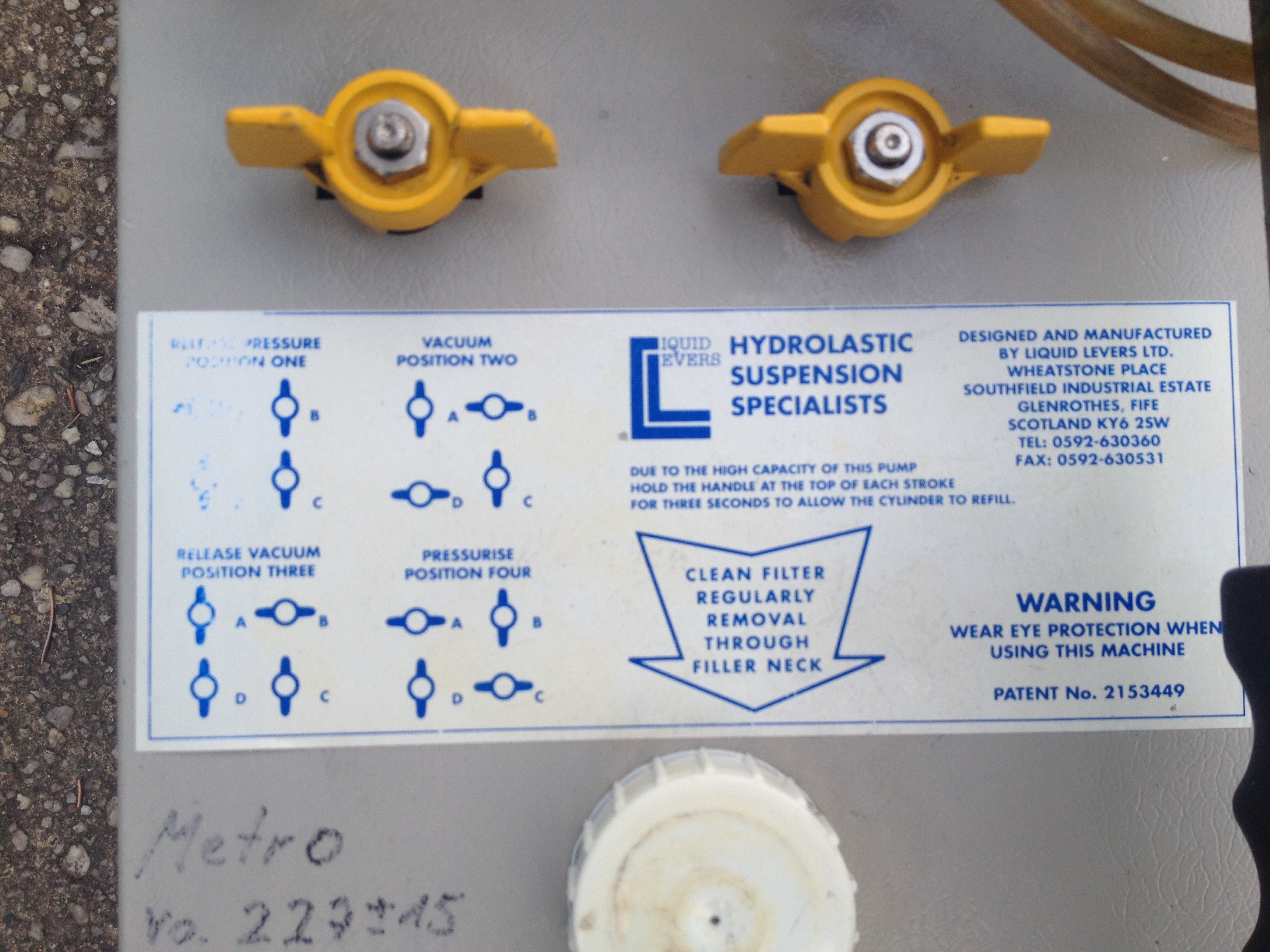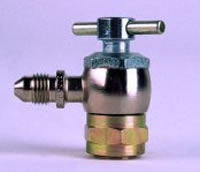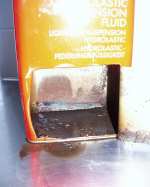The magic pump for the MGF and MGF Trophy suspension works
Introduction
When I purchased my
second hand 1996 built MGF in October 1998 I nearly knew nothing about
the combined spring and damping system developed by Sir Alex Moulton.
Nearly nothing, only that my MGF must have a problem with his current
suspension setup.
- It was wobbly without moving the steering from right to left on accelerating.
- At about 80 mph the steering began to shake and on windy conditions
the same happened
- I got fear to travel faster then 80mph because it nearly was blown off
the road.
What now ? Reject
the car ?
No, I'm an engineer ! Not educated for car works but with wide skills
in several mechanical technologies. I should give up ? Never ! I tried
to find friends succesful on the Internet Michael Bender showed me with
his Website whats going on there, Great !!
I explored the UK based BBS, found hundreds of entrys on suspension threads
and got my first blame there on asking stupid questions :
' is that for the hydragas system used pump equal to a Citroen cars pump'
and things like that. ;-)
My MGFs suspension was corrected by a friendly dealer. I learned a lot
at the BBS and while serving my own technical based Website.
The suspension system got my favourite technical discussion term. I ever
used to find out how things work at my cars not only to repair it myself,
but as a hobby.
This mystery hydragas system must be worked out.
It lasted about 3/4 years until I got contact to Carl, from Sweden. He
was interested too in collecting each and everything related to the MGF
and had already a lot of experiance. Rob Bell, Ted Newman, Thomas Ohms,
John Thomas, Tony Smith, Kes from Kidderminster and Roger Parker and some
more. A kind of team of well known names put their little bit to this
summary of one year research on things that nobody else in Germany was
seams to be interested in.
Now, what is it good for ? Only for my fun on finding out things that
nobody 'should know'.
I did it and do it because it is possible.
The other reason: Improving my english language skills. Thats all.
See this Webside and enjoy it.
Principals of the MGF hydragas suspension
Rob's webside on hydragas suspension principals
Ride hight, the vital term for the MGFs riding comfort
Lowering by works at the standard knuckle set
Building and use of a home made Hydragas Pump
Pump use at an LHD MGF, some data
Cut through a broken MGF Hydragas Unit
Change of a blown right rear Hydragas unit #1 blown right rear Hydragas unit #2
Building and use of a home made evacuation system [under construction]
MGF Lowering with the simple pump set (pressure and evacuate)
MGF bump stops installation (pressure pump used)
Four wheel alignement of the MGF [under construction]
Pump Gallery
Liquid Levers Pumps
 simple version *pressure only* at Liquid
Levers and ....
simple version *pressure only* at Liquid
Levers and ....  the very Hydravac (2004) including vacuum function, 18G 703Q .
the very Hydravac (2004) including vacuum function, 18G 703Q .
 © 2001 Manfred Kribbel
© 2001 Manfred Kribbel  ..
from inside
..
from inside


 Spyros :)
Spyros :)
 Same Pump at Hanah's workshop in NZ
Same Pump at Hanah's workshop in NZ
sticker on earlier 18G703X
with 4 valves on how to set the valves


Unit1, Mountfleurie Ind Estate Lerven, Fife, KY8 4AX, Scotland UK
Vacuum Hydrolastic
Suspension Pump
[Part-number: HYV - Rover ref. 18G703Q]
1: Initial procedure
Fill the machine reservoir with the correct fluid
Set the valve to pressure
Make sure that the vehicle is on level ground with the handbrake off
Remove dust cap on car hydrolastic / hydragas connector
Fully slacken tap T (if available) by turning anti-clockwise, also
slacken bleed screw by turning anti-clockwise two turns
Screw on the body of the low loss connector as far as possible (by hand !)
Operate the pump handle to fill the plastic tube, thenm close valve T (if available)
Connect the vehicle hydrolastic / hydragas fluid by turning tap R fully clockwise
2. Raising trim height
If merely increasing trim height, set valve´to pressure and pump up to the required height / pressure
3. Checking trim height
Roll the car back and forth and bounce the suspension before checking the vehicle trim height. Adjust downwards, if required, by sliding the valve to depressurise until the required height is achieved.
4 Depressurise the System
Slide the valve to depressurise
WARNING - Both the pressure and vacuum gauges are isolated during the depressuriseing sequence. Before opening the system on the vehicle, slide the valveto pressure to check the pressure is zero
5. To vacuum the system
Depressurise the system; making sure no pressure is left by returning the valve to pressure and checking that the pressure gauge is at zero
Slide the valve to vacuum and operate the pump till the required vaccum is reached.
The fluid from the vehicle will be returned to the reservoir. If there is any doubt about the fluid drawn from the vehicle, empty the reservoire and dispose of the fluid correctly - treat as brake fluid or anti-freeze.
WARNING - If pressure is within the system if the valve is put to vacuum position, damage to the vacuum gauge may result.
6 To releive Vacuum
Slide the valve to depressurise. Fluid wil be drawn back to the system from reservoire. Make sure that there is adequate fluid in the reservoire. Remember only to use the correct fluid.
7. To pressurise the system
As step 2
pdf instructions

Leyland tool number 18G703 later 18G703V
Might be similar
to this one http://members.cox.net/oldertech/hydrolastic.htm
 Tims pump (obsolete no more production)
(ALBA )
Tims pump (obsolete no more production)
(ALBA )
Easy grease pump with bolt on truck tyre adapter might work to, as shown
by Andreas K.

See at Lumatic i.e E500
See what charless from the UK has got in 2010 at the MGF Register Forum Y 01.2010
It is an oil gun with a T-piece
to accommodate the unnecessary luxury of a pressure gauge (both parts
from http://www.pressureguage.co.uk
c.£33 delivered). The low loss connector made by Schrader (possibly
cheaper source) came from http://www.prosol.co.uk
c.£50 delivered. The connector's thread is 3/8 UNF. Many oil guns
are available from well under £20 (but I already had one), finding
one with the 3/8 UNF gives you a straightforward screw together tool.
I added a couple of turns of plummer's PTFE tape to proof each screw connection.
Hydraulic threads tend to be British Standard Pipe (BSP) or Unified Fine
Thread (UNF) The common sizes of which can be bought in one tap &
die kit from Machine Mart (kit CHT304 includes the metric range as well
as BSP and UNF c.£38).
This beast can probably pump watery liquid well over 2000 psi safely,
it is rated at c.6000 for oil - I only need c.400 psi for the Fs - so
I can pump them up in the cold weather and get much better headlight beam
pattern, then let them back down again in the summer.

2003 enhenced with Liquid Lever connector :)
Gas Chuck (Accumulator Charging Valve)
Parker 0.305-32 UNS (No 8708150000 )
Low loss connector
from PROSOL
(found by Chris B. © 2008 )
 LLC4690 for about 30 Pound
LLC4690 for about 30 Pound
plus
Lumatic Oil Gun (Type OLGH/CV does 8.500 psi (600 bar)) and hydraulic
bits from http://www.pirtek.co.uk/
Jon used the Lumatic
E500
basic cheap one from SKS
valve (Amazon)
 ©
1998-2001 Carl the DIY suggestion came from Sweden.
©
1998-2001 Carl the DIY suggestion came from Sweden. © 2000-2001 Dieter
DIY
© 2000-2001 Dieter
DIY  Construction works hydraulic jack. ... good for 300 bar ;)
Construction works hydraulic jack. ... good for 300 bar ;)
Modified due to the hints on this site for JM in Argentina. Looks great
and much better then those below here.
Valter Fernandes, fellow F'er from Portrugal used an
old hand pump to open Aircraft's engine cowls.
Mmachined adaptor to fit on the hydragas nipples and throughout cleaned
the pump and flushed the circuit, till it was free from any oil.
Jjust had to imerse one end to the bottle and to screw the other end to
the hydragas system.
 © 2000 Don Liang DIY
© 2000 Don Liang DIY
latest product is a test pressure
pump for plumbers, like this one up to 30bar (480psi)
 together with a cheap low los valve for bicycle dampers like this one
from SKS for USP/MSP pump
together with a cheap low los valve for bicycle dampers like this one
from SKS for USP/MSP pump 
An adaption of the SKS valve to the testpump needs to be sourced.
According to the paperwork that comes with the Hydragas pump, these are the cars with Hydragas and Hydralastic suspension and their front wheel trim heights... [Thanks to Andy]
| Hydragas type | Trim Front | Height rear | Tol. | Pressure | connector
location |
comments |
| MGF | 368mm | 358mm | 10mm | 450lb/sq" approx. | under bonnet | temperature
correction: 0,6mm per degree (17° C) front linked to rear (LH or RH) |
| MGF Trophy | 348mm | 338mm | 10mm | 450lb/sq" approx. | under bonnet | temperature
correction: 0,6mm per degree (17° C) front linked to rear (LH or RH) |
| Metro 1980 - 1990 | 12 7/8" | 12 6/8" | 3/8" | 420lb/sq" | under bonnet & front of rear L/H wheel | independent front suspension units; rear units linked |
| Metro 1990 onwards | 341mm | N/A | 10mm | N/A lb/sq | under bonnet & front of rear L/H wheel |
independent front suspension units; rear units linked |
| Ambassador | 14 1/2" | N/A | 1/4" | 350lb/sq appox. | under bonnet | |
| Allegro to car no. 226629 | 14 3/4" | N/A | 3/8" | 340lb/sq appox. | under bonnet | |
| Allegro car no. 226629 onwards | 14 1/2" | N/A | 3/8" | 340lb/sq appox. | under bonnet | |
| Maxi - 1970 Maxi 1971 - 1977 Maxi 1978- |
14 1/8" | N/A | 3/8" | 245lb/sq" 225lb/sq" 230lb/sq" |
under small panels on boot floor | |
| Hydralastic type | ||||||
| Mini up to Dec 1965 | 13" | 13 1/2" | 1/4" | 263lb/sq" | under rear of car | |
| Mini from Dec 1965 | 12 5/8" | 13 1/8" | 1/4" | 282lb/sq" | ||
| Mini Clubman | 13 1/2" | 13 1/2" | 1/4" | 292lb/sq" | ||
| Princess | 14 1/2" | N/A | 3/8" | 350lb/sq" | under bonnet | |
| Princess Mk1 | 13 5/8" | N/A | 3/8" | 230lb/sq" | under bonnet | |
| Austin/Morris/Wolseley 1800/2200 | 14 7/8" | N/A | 1/4" | 245lb/sq" | under bonnet | |
| Austin, Morris, Wolseley, Riley | 13 5/8" | N/A | 3/8" | 205lb/sq" | under bonnet | |
| MkII 1100 & 1300 with arch rear spring | 14" | N/A | 3/8" | 195lb/sq" | under bonnet | |
| MG Normal Air
(I assume this is the 1100 / 1300) |
13 5/8" | N/A | 3/8" | 220lb/sq" | under bonnet | |
| 1300 GT | 13 5/8" | N/A | 205lb/sq" | under bonnet |




